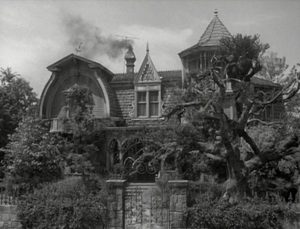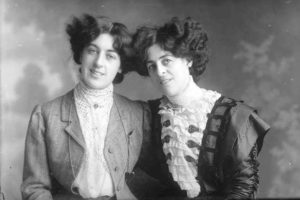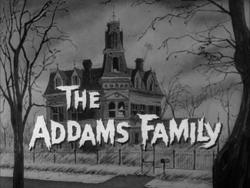1909: Gothic Revival Hair
November 13, 2020
By AHNZ
The way we look at the distant past, such as the time period Anarchist History calls Dominion Victimhood Culture (c.1907-1912) is conditioned by the less distant past. Our intermediary to this 1909 ‘cartwheel hair style’ (image left) is the generation that followed and they were not so impressed.
 Miss Cothams’ hairstyle (I take it the women in this picture are sisters) evolved out of a design intended for the wearing of the cartwheel hat. A little earlier on Western women always wore hats or bonnets to cover their heads in the same way Muslim women still do today with their burkas and hijabs. We Westerners chide the Muslims for being backward this way (without considering the good points) and forget that our Colonial ancestors were doing the same. Hair like this looked pretty good when rising up like latte coffee foam to meet a cartwheel hat.
Miss Cothams’ hairstyle (I take it the women in this picture are sisters) evolved out of a design intended for the wearing of the cartwheel hat. A little earlier on Western women always wore hats or bonnets to cover their heads in the same way Muslim women still do today with their burkas and hijabs. We Westerners chide the Muslims for being backward this way (without considering the good points) and forget that our Colonial ancestors were doing the same. Hair like this looked pretty good when rising up like latte coffee foam to meet a cartwheel hat.
All the Cotham women had to do to be innovative, hip/awesome/bad/cool/funky/spiffing/cutting edge was to remove the hat and sport that hair in public as a style in itself.
Neo Gothic Revival
 This must have been highly avant-garde to New Zealanders, and the world, at the time. Of course, as always, the next generation would come to associate it with the musty old past. We’ve been taught by people like Charles Addams through his cartoons and TV show, The Addams Family, to look back on the Neo Gothic as old and spooky. Creaking old dark houses, cobwebs, archaic and quirky architecture and clothing. 1960s TV shows The Munsters, Addams Family, and Dark Shadows were all a sort of on-screen exorcism to process the spooky older generations and relegate them to a safe and obsolete place in our cultural conscience. This was obviously no small task since those shows (not sure about Dark Shadows) ran and re-ran for 30 years or more even in New Zealand as we worked though psychodrama through its course.
This must have been highly avant-garde to New Zealanders, and the world, at the time. Of course, as always, the next generation would come to associate it with the musty old past. We’ve been taught by people like Charles Addams through his cartoons and TV show, The Addams Family, to look back on the Neo Gothic as old and spooky. Creaking old dark houses, cobwebs, archaic and quirky architecture and clothing. 1960s TV shows The Munsters, Addams Family, and Dark Shadows were all a sort of on-screen exorcism to process the spooky older generations and relegate them to a safe and obsolete place in our cultural conscience. This was obviously no small task since those shows (not sure about Dark Shadows) ran and re-ran for 30 years or more even in New Zealand as we worked though psychodrama through its course.
This process was so successful that it’s hard to look back on these haircuts or the Gothic Revival without slipping into the lens of Addams¹. The people, in particular, come to the minds eye as old people in antique clothing. Possibly ghosts haunting some old house. In their day, in Benjamin Mountfort’s day, they were the trend setters. Mountfort, the great architect of colonial Canterbury, would have acted and dressed and been regarded as super-cool in his day not some 2D Scooby Doo villain.
Dominion Victimhood Culture

Dominion Victimhood Culture takes its name from the pretentious idea at the time to re-classify New Zealand as a “dominion.” This status was bestowed on 26 September, 1907. “Dominion Day” was a political vehicle for our Prime Minister Joseph Ward (left.)
“The historian of the future,” said Ward on Dominion Day, “will refer to to-day as a great epoch in the history of this country.”²
The term and idea was mocked, even at the time by Kiwis but it stuck for a long time anyway, much like their hairstyles.
 Dominion Victimhood Culture had all the fine dress of Dignity Culture but gone wild (especially in the hair department..) This careless flamboyance was yet to have its comeuppance in 1909 but was careening toward it in the form of ‘Gallipoli Slave Culture’
Dominion Victimhood Culture had all the fine dress of Dignity Culture but gone wild (especially in the hair department..) This careless flamboyance was yet to have its comeuppance in 1909 but was careening toward it in the form of ‘Gallipoli Slave Culture’
(c.1912-1915.)
On the Moral Culture Clock, if you will, this photo (above) is equivalent to where New Zealand was in about 2018 too. These ladies were probably just the sort who funded Plunket Eugenics and gave ‘white feathers’ to young men so they would leap into the WW1 meat grinder.
—
1 Another aspect to explore is how Addams and Munsters neutralise by mockery the diversity and extent of the earlier generations and their culture. Earlier families were vast and inter-connected by localism, alliances, and marriages, extended cousinage. This was useful in New Zealand, a start-up nation. The 1960s shows converted this, satirically, into an urban nuclear family setting which made all that human capital power and specialisation look ridiculous.
2. A World History of Bluff; Facebook
Image ref. Miss Cotham and Miss Cotham; Auckland Libraries Heritage Collections; Auckland Research Centres, Facebook
Image ref. Cartwheel hat; hair-and-makeup-artist.com
Image ref. The Munsters House
Image ref. The Addams Family House
 Like Comment Share
Like Comment Share






